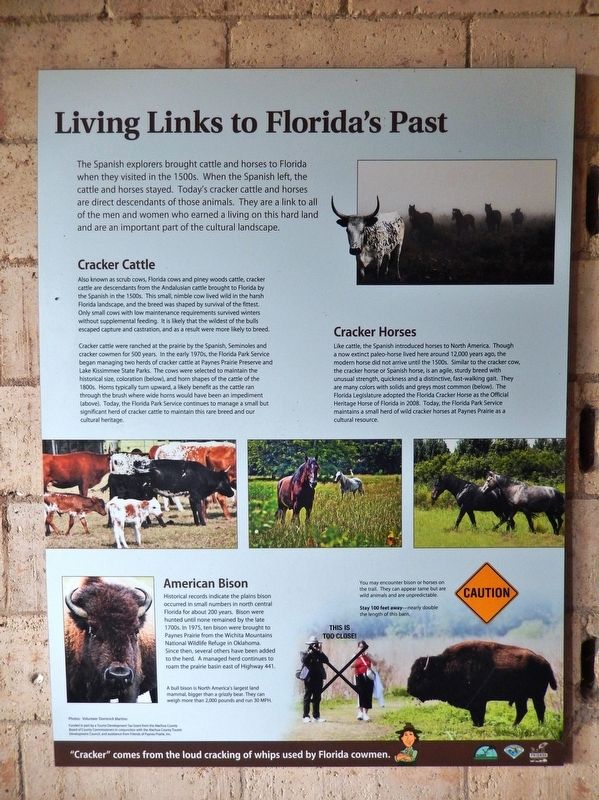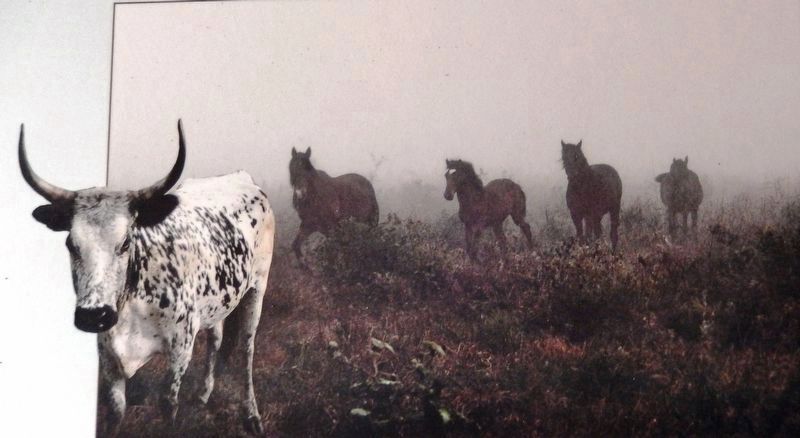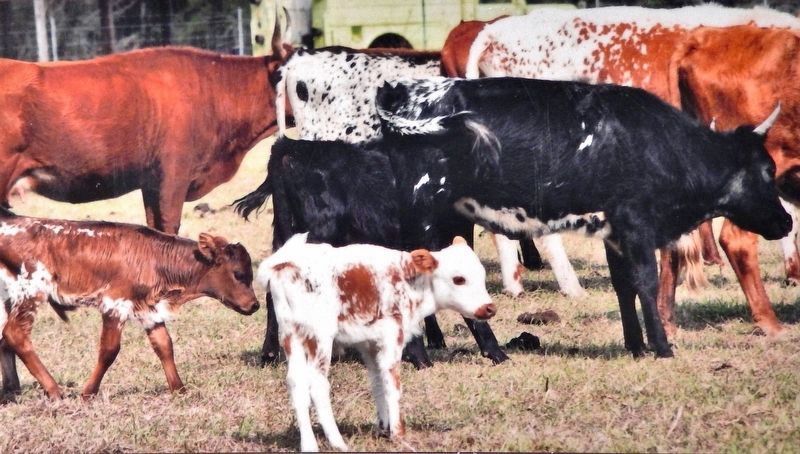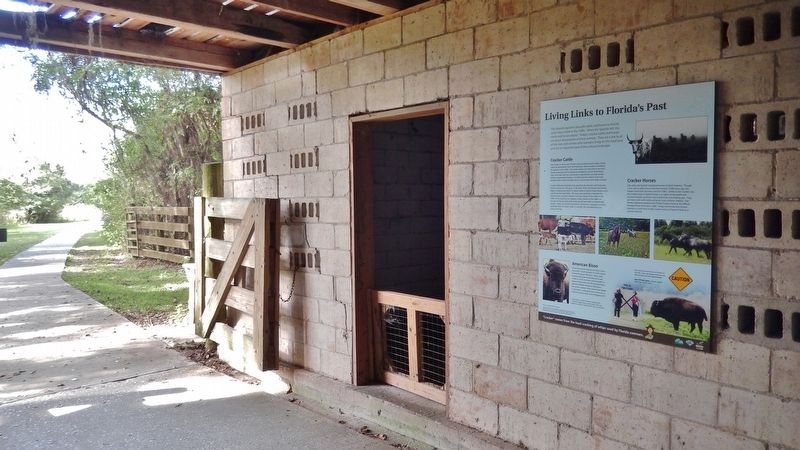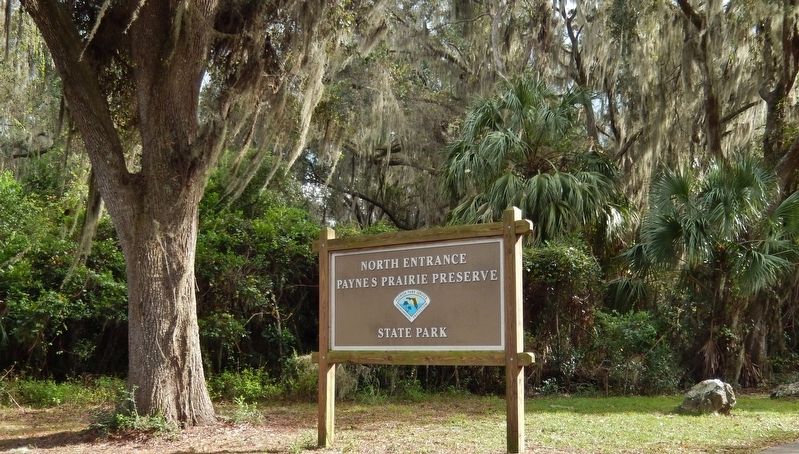Gainesville in Alachua County, Florida — The American South (South Atlantic)
Living Links to Florida's Past
Cracker Cattle
Also known as scrub cows, Florida cows and piney woods cattle, cracker cattle are descendants from the Andalusian cattle brought to Florida by the Spanish in the 1500s. This small, nimble cow lived wild in the harsh Florida landscape, and the breed was shaped by survival of the fittest. Only small cows with low maintenance requirements survived winters without supplemental feeding. It is likely that the wildest of the bulls escaped capture and castration, and as a result were more likely to breed.
Cracker cattle were ranched at the prairie by the Spanish, Seminoles and cracker cowmen for 500 years. In the early 1970s, the Florida Park Service began managing two herds of cracker cattle at Paynes Prairie Preserve and Lake Kissimmee State Parks. The cows were selected to maintain the historical size, coloration (below), and horn shapes of the cattle of the 1800s. Horns typically turn upward, a likely benefit as the cattle ran through the brush where wide horns would have been an impediment (above). Today, the Florida Park Service continues to manage a small but significant herd of cracker cattle to maintain this rare breed and our cultural heritage.
Cracker Horses
Like cattle, the Spanish introduced horses to North America. Though a now extinct paleo-horse lived here around 12,000 years ago, the modern horse did not arrive until the 1500s. Similar to the cracker cow, the cracker horse or Spanish horse, is an agile, sturdy breed with unusual strength, quickness and a distinctive, fast-walking gait. They are many colors with solids and greys most common (below). The Florida Legislature adopted the Florida Cracker Horse as the Official Heritage Horse of Florida in 2008. Today, the Florida Park Service maintains a small herd of wild cracker horses at Paynes Prairie as a cultural resource.
American Bison
Historical records indicate the plains bison occurred in small numbers in north central Florida for about 200 years. Bison were hunted until none remained by the late 1700s. In 1975, ten bison were brought to Paynes Prairie from the Wichita Mountains National Wildlife Refuge in Oklahoma. Since then, several others have been added to the herd. A managed herd continues to roam the prairie basin east of Highway 441.
Erected by Alachua County Board of County Commissioners, Alachua County Tourist Development Council, and Friends of Paynes Prairie, Inc.
Topics. This historical marker is listed in these topic lists: Animals • Colonial Era • Exploration.
Location. 29° 36.448′ N, 82° 18.19′ W. Marker is in Gainesville, Florida, in Alachua County. Marker can be reached from Southeast 15th Street (Camp Ranch Road), 0.4 miles south of Southeast 41st Avenue when traveling south. Marker is located on the La Chua Trail, in Paynes Prairie Preserve State Park, 1/4 mile south (by foot only) of the La Chua Trailhead. Touch for map. Marker is at or near this postal address: 4270 Southeast 15th Street, Gainesville FL 32641, United States of America. Touch for directions.
Other nearby markers. At least 8 other markers are within 3 miles of this marker, measured as the crow flies. A Cattle Economy (a few steps from this marker); Alachua Sink (within shouting distance of this marker); Trains Rumbled Overhead (about 400 feet away, measured in a direct line); Gainesville’s Only Artesian Spring (approx. 0.9 miles away); Boulware Springs Water Works Building (approx. one mile away); Jesse Johnson Finley (approx. 1.6 miles away); Evergreen Cemetery (approx. 1.8 miles away); Serenola Plantation (approx. 2½ miles away). Touch for a list and map of all markers in Gainesville.
More about this marker. This marker is a large composite plaque, mounted on the old horse barn outside wall, alongside the La Chua Trail.
Regarding Living Links to Florida's Past. "Cracker" comes from the loud cracking of whips used by Florida cowmen.
Also see . . .
1. Florida Cracker cattle. Florida Crackers are one of the oldest and rarest breeds of cattle in United States. Descended from Spanish stock imported to the continent in the 16th century, Florida Crackers are a small, horned breed that quickly adapted to the Florida landscape and have long been prized for their resistance to parasites and other hardy traits. They weigh generally under 900 pounds, come in many colors, and both males and females are horned. (Submitted on November 19, 2018, by Cosmos Mariner of Cape Canaveral, Florida.)
2. Florida Cracker Horse. Horses first arrived on the southeast
North American mainland in 1521, brought by Ponce de Leon on his second trip to the region, where they were used by officers, scouts and livestock herders. Later expeditions brought more horses and cattle to Spanish Florida. By the late 16th century, horses were used extensively in the local cattle business and by the late 17th century the industry was flourishing, especially in what is now northern Florida and southern Georgia. These horses developed into the Florida Cracker type seen today, and continued to be used by Florida cowboys (known as "crackers") until the 1930s. (Submitted on November 19, 2018, by Cosmos Mariner of Cape Canaveral, Florida.)
Credits. This page was last revised on November 26, 2018. It was originally submitted on November 16, 2018, by Cosmos Mariner of Cape Canaveral, Florida. This page has been viewed 398 times since then and 54 times this year. Photos: 1, 2, 3, 4, 5, 6. submitted on November 19, 2018, by Cosmos Mariner of Cape Canaveral, Florida. • Bill Pfingsten was the editor who published this page.
